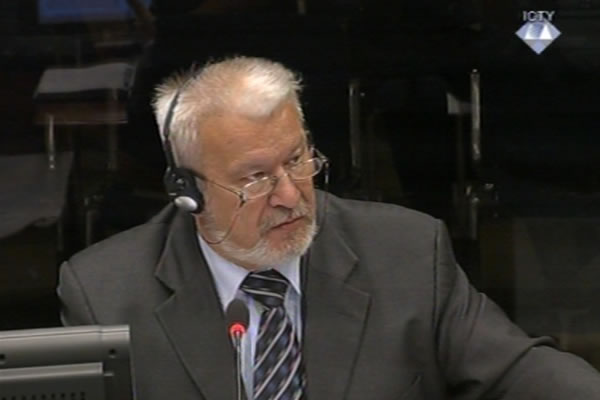Home
PROSECUTION: WRONG CONCLUSIONS BASED ON SELECTIVE SOURCES
In the cross-examination of Karadzic’s defense expert Dusan Dunjic, the prosecution suggested that the witness ‘skipped over’ all the indicators that run counter to his conclusions and relied only on those corroborating the defense case. Dunjic claimed that most of the Srebrenica Bosniaks exhumed from the mass graves had not been killed in the mass executions
 Dusan Dunjic, defence witness of Radovan Karadzic
Dusan Dunjic, defence witness of Radovan Karadzic The cross-examination of Dusan Dunjic, a professor of forensic medicine from Belgrade, continued as the prosecution contested his claims that many of the bodies buried in the Zvornik and Bratunac area in July 1995 did not belong to the victims of mass executions. In the two reports Dunjic wrote for Radovan Karadzic’s defense, he claimed that it was possible that most of those men had died in combat or had been killed before or after July 1995.
The prosecutor first contested the witness’s allegation that the different stages of decomposition indicated they were killed at different times and places. Prosecutor Mitchell argued that the anthropologists that testified before the Tribunal established that the mass graves were disturbed only when the bodies were moved from primary to secondary graves; this operation was conducted by the Bosnian Serb army. The prosecution experts have also stated in their reports that the World War II burials also exhibited different stages of decomposition in bodies that were buried at the same time. The decomposition rate will depend on the position of the body in the grave, the prosecution experts have explained. Bodies buried at the edges and on top of mass graves decompose faster than those buried deep inside them. Dunjic agreed with the explanation but added that his theory was also possible.
The fact that rifle bullets were recovered from some bodies showed, in Dunjic’s view, that the victims were killed from a distance, in combat or that the bullets had previously passed through some natural barrier, perhaps even another body. In an execution, rifle bullets as a rule enter and exit the body. The prosecutor put it to Dunjic that latter theory offered by the witness was the only acceptable option. The prosecutor brought up a statement made by a defense witness who is slated to give evidence next week, former member of the 10th Sabotage Detachment Franc Kos, who said that at the Branjevo farm the prisoners were executed in rows. The bullets thus passed through the men who were standing and fell on those who were already on the ground, dead. Dunjic replied that it was ‘just one explanation’.As for the shrapnel wounds, the witness claimed that they were inflicted in combat. This prompted the prosecutor to remind Dunjic that a number of witnesses stated that hand grenades were thrown at the prisoners in the Kravica warehouse.
Finally, the prosecutor asked Dunjic if he compared the wounds on the bodies whose hands had been tied with those on the bodies whose hands were unbound. Dunjic had himself admitted that the victims whose hands had been tied had been executed. If the wounds were the same, the prosecutor suggested, it would ‘lead to a conclusion’ that they all died in the same manner, i.e., that they were executed. The Belgrade professor admitted that he didn’t conduct this kind of analysis.
Things got rather intense at the end of the cross-examination when the witness said that about 100 Bosniaks from Bratunac were on the list of missing persons from Srebrenica. Dunjic claimed that in May 1992 he and a team of pathologists from Belgrade had examined their bodies at the Vuk Karadzic primary school. The prosecutor insisted that the witness ‘made the story up’. Dunjic was thus prompted to explain his logic: he linked the event in 1992 with the witness statements and the experts’ findings to the effect that 80 bodies brought from the primary school had been buried in the Glogova grave in July 1995. The prosecutor argued that the victims were killed in 1995. Finally, Dunjic admitted that he didn’t know the identity of the 100-odd bodies he examined in 1992 in the primary school and that thus he couldn’t say that their names were on the list of missing persons from Srebrenica. The prosecutor ended the cross-examination at that point.
After Dunjic completed his evidence, the defense’s military expert Dragomir Keserovic returned to the courtroom. Keserovic’s evidence was put on hold on 8 July 2013.
Linked Reports
- Case : Karadzic
- 2013-07-23 KARADZIC’S EXPERT PREPARED TO ACCEPT JUST 500 SREBRENICA VICTIMS
- 2013-07-22 WITNESS WITH ‘CLEAR CONSCIENCE’ AND PROBLEMATIC PAST
- 2013-07-19 HOW SREBRENICA OPERATION TURNED INTO A CRIME
- 2013-07-25 FORCED TO ‘DISARM PEOPLE FORCIBLY’
- 2013-07-29 MENDELJEV DJURIC’S ‘CATEGORICAL DENIALS’
- 2013-07-30 FORMER POLICEMAN’S LAW CAREER
